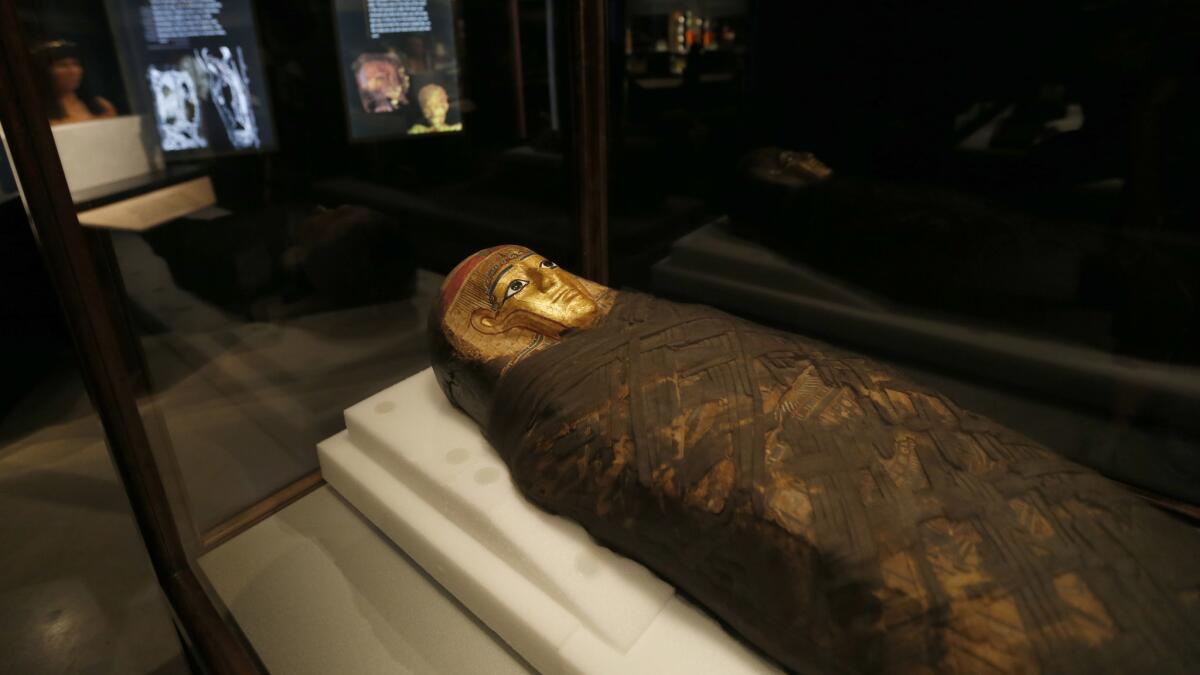At Natural History Museum, mummies’ secrets unwrapped with today’s tech

Modern technology gives various views of the mummies in the Natural History Museum exhibition.
- Share via
The Natural History Museum’s latest exhibit, “Mummies: New Secrets From the Tombs,” uses interactive touch tables to do virtually what visitors might not want to do in reality: Unwrap the cloth of 19 ancient mummies from Egypt and Peru.
It’s a show that’s “going to be remembered for years to come,” said Karen Wise, vice president of education and exhibits at the Natural History Museum of Los Angeles County. “This collection of really important artifacts is presented in a new way, celebrates their beauty and explores what we know and how we know what we know.”
SIGN UP for the free Essential Arts & Culture newsletter >>
“Mummies” is the first touring exhibition of North America’s largest collection of mummies. Organized by the Field Museum in Chicago, the collection hasn’t traveled outside its Illinois home in more than 120 years. Los Angeles museum-goers are the first to explore the rare specimens as they travel on a national tour before returning to the Field in 2018.
Mummification in Egypt and Peru is examined through an immersive exhibit spanning almost 10,000 square feet. The interactive touch tables allow visitors to explore the interior of mummies. According to Ryan Williams, anthropology department chairman of the Field’s Integrative Research Center, mummies were scanned using an X-ray computed tomography, or CT, machine. This noninvasive technique allowed researchers to avoid the hazards of physically unwrapping the fragile bodies while trying to derive biological and cultural information from the remains.
“When the mummies are wrapped, you don’t really know who is inside,” Williams said.
Scanning the mummies allowed researchers “to determine the age, sex, infirmities and pathologies these people had,” he said. “This technology, more or less nondestructively, helps us understand the people beneath the bundles.”
Some of the mummies that visitors can unwrap include one dubbed Minirdis, a 14-year-old boy, as well as a 40-year-old woman known as Gilded Lady. The CT scans show her overbite and Cleopatra-like curly hair.
Also part of the exhibit: 3-D-printed casts of bones and burial figurines, mummified animals and forensically reconstructed sculptural busts by artist Elisabeth Daynès.
Though most of the mummies are from Egypt, five are from Peru, a country whose mummification tradition predates that of Egypt. The exhibit explores the similarities and differences between the two cultures’ traditions, Field curator Jim Phillips said, and shows that mummification was something of an accidental development in Egypt, but its spread was more deliberate in Peru.
“Mummification is universal,” he said. “When people die, they are kept around. It’s nothing new, and it is so important to all societies, but the manner is very different.”
Wise hopes that museum visitors enjoy ancient artifacts presented in a modern way, “not just as objects but as things we can learn from,” she said. “I want them to be inspired to learn more.”
Twitter: @TrevellAnderson
------------
‘Mummies: New Secrets From the Tombs’
Where: Natural History Museum of Los Angeles County, 900 Exposition Blvd., Los Angeles
When: 9:30 a.m. to 5 p.m. daily, through Jan. 18
Tickets: $22
Info: (213) 763- 3466, nhm.org
More to Read
The biggest entertainment stories
Get our big stories about Hollywood, film, television, music, arts, culture and more right in your inbox as soon as they publish.
You may occasionally receive promotional content from the Los Angeles Times.











